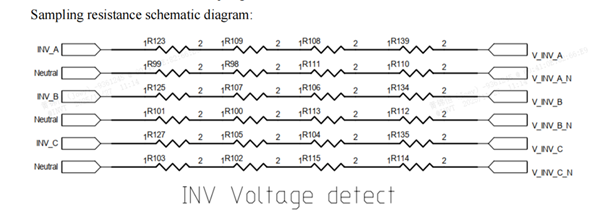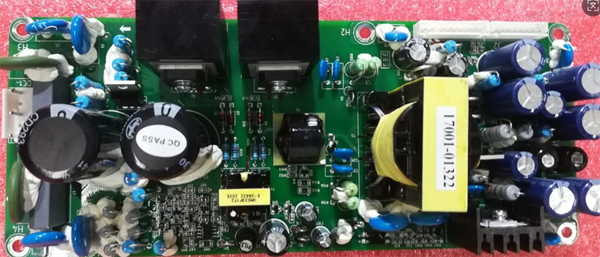Q1 : What is a sampling resistor circuit? What is its function in a UPS?
* Sampling resistor circuit:
A sampling resistor circuit , also known as a current sensing circuit, is a circuit that indirectly calculates the current flowing through a branch by measuring the voltage drop across a known resistance resistor.
- Its core principle is based on Ohm's law:
V = I × R
- Where:
V is the voltage drop across the sensing resistor.
I is the current flowing through the sensing resistor (which is the current we want to measure).
R is the resistance of the sensing resistor.
Since the resistance value R is known, as long as the voltage V across it is accurately measured, the current I = V / R can be easily calculated .
* The role of the sampling resistor circuit in a UPS:
1. System monitoring and status diagnosis
2. Overcurrent and short circuit protection
3. Closed-loop control
* Sampling resistor circuit physical diagram and circuit diagram (Figure 1 is the physical diagram on the PCB board, and Figure 2 is its circuit diagram)

Figure 1

Figure 2
Q2: What fault information will the UPS report when the sampling resistor circuit fails/the current in a certain circuit is abnormal?
A: The UPS will report ‘Bypass Volt Detect Fail-Set’ fault (as shown in Figure 3 below).

Figure 3
NOTE: The Figure shows '2# Bypass Volt Detect Fail-Set' fault, where 2# refers to module 2 and 0# to the bypass module.
Q3: When the UPS reports ‘Bypass Volt Detect Fail-Set’ fault, what are the typical troubleshooting steps?
A: When the sampling resistor circuit is faulty, the typical troubleshooting steps are as follows:
1. Check the actual input/output values of the circuit based on the location of the fault;
2. If the actual input/output values are normal, consider whether the detection circuit on the PCB board is faulty; (For modular UPS systems, first determine if the power module/bypass module detection circuit is faulty)
Q4: How to detect whether the sampling resistor circuit on the PCB board is faulty?
A: The method for detecting a sampling resistor circuit fault is as follows:
1. Locate the corresponding point on the PCB board; use the ohmmeter function (Ω) of a multimeter; touch the two points on the PCB board by the multimeter probes; check whether the resistance value is within the effective range (the deviations of resistance value will vary depending on the type of resistor) ; (The detection points are shown in Figure 4).
 Figure 4
Figure 4
Q1: What alarms does the UPS typically display when the fan malfunctions? A: When the fan malfunctions, the UPS will typically display "Fan Fail-Set" (as shown in Figure 1 below).

Figure 1
NOTE: The Figure shows ‘0# Bypass Fan Fail Set’ fault, where ‘0#’ is the bypass module and ‘X#’ is module X.
Q2: What are the common causes when the UPS displays a "Fan Fail-Set" alarm?
A: The main causes of ‘Fan Fail-Set’ alarm on the UPS are as follows:
1) Fan/fan power cable failure
2) Fan signal cable failure (white signal cable from the fan power board to the fan)
3) Short-circuit function failure of the fan power board (the short-circuit point may vary depending on the model)
4) Fan power board failure
5) Auxiliary power board failure
6) Monitoring signal cable failure (signal cable from the monitoring board to the fan power board)
7) Monitoring board failure
Q3: What are the usual troubleshooting steps when the UPS displays 'Fan Fail-Set' alarm?
A: The usual troubleshooting steps when the UPS displays ‘Fan Fail-Set’ alarm are as follows:
1) Use a jumper cap to short-circuit the power signal interface of the fan power board, and test interfaces 1—n+1 in sequence.
If there are no alarms, it is normal. If there are alarms, the source of the fault needs to be identified. The source of the fault can be determined by replacing the fan or by interface testing (as shown in Figure 2).

Figure 2
2) If the source of the fault cannot be determined in the first step, continue to check:
① Fan power supply board:
J1: Fan PWM signal and LED indicators signal, power supply (as shown in Figure 3 below)
 Figure 3
Figure 3
② Check if the auxiliary power board is faulty: If the power board is supplying power normally, its LED light will light up (as shown in Figure 4 below).

Figure 4
3) If the source of the fault cannot be determined in the second step, further checks are required:
① Replace the monitoring board
② Replace the cable connecting the monitoring board to the fan power board.
Higher values for P4.60 and P4.61 cause longer deceleration time during shutdown. Increase the position loop gain of P2.02.
This is the EtherCAT monitoring interface. Setting P0.15 to 0 will resolve the issue.
This method cannot clear multi-turn positions. It can be used to clear accumulated absolute position feedback, accumulated commands R2.05 and R2.04. To clear multi-turn positions, use P0.71.
After enabling the multi-turn mode, the customer expects the R0.25 value to continue increasing beyond 32,767 revolutions, but in practice it does not increase continuously.
Solution:
R0.25 represents the actual encoder's multi-turn value. This 16-bit value is hard-coded and cannot be modified. However, with the multi-turn mode activated, the cumulative position feedback value stored in R2.05 persists even after power loss following a multi-turn overflow. This ensures the absolute position is preserved and not lost during power failure."
Excessive PDO count in the PLC has caused an overly high task load rate. Deleting unnecessary PDOs will resolve the issue.
When P11.01 is enabled and a transient power-off occurs, bit 9 is set to 1 when the bus voltage is lower than the following values: 460VDC for 380VAC models; 240VDC for 220VAC models.
What are the differences and triggering conditions between P11.01 (Frequency drop at transient power-off) and P11.16 (Automatic frequency-reduction during voltage drop) on GD28 drive?
Solution:
When P11.01 is enabled, in the event of a short-term bus voltage drop, the VFD will reduce its output frequency to brake the motor, in motor brake status, it will generate energy to maintain the bus voltage.
When P11.16 is enabled, when the bus voltage decreases, the VFD's output frequency will decrease synchronously. This applies to both VF and vector modes.



Our site uses cookies to provide you with a better onsite experience. By continuing to browse the site you are agreeing to our use of cookies in accordance with our Cookie Policy.